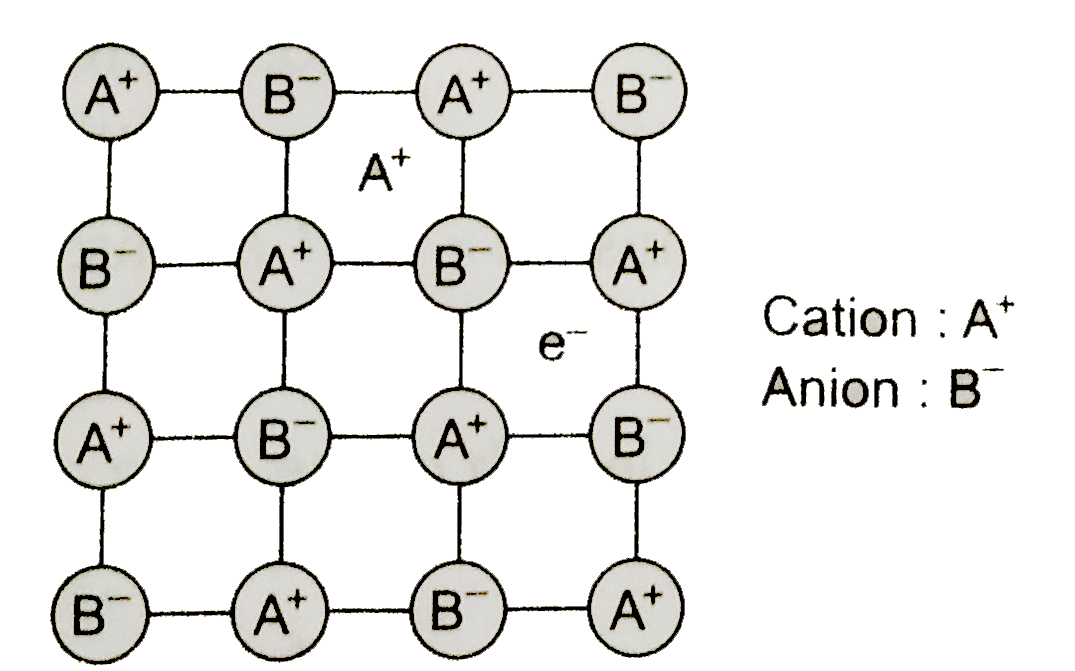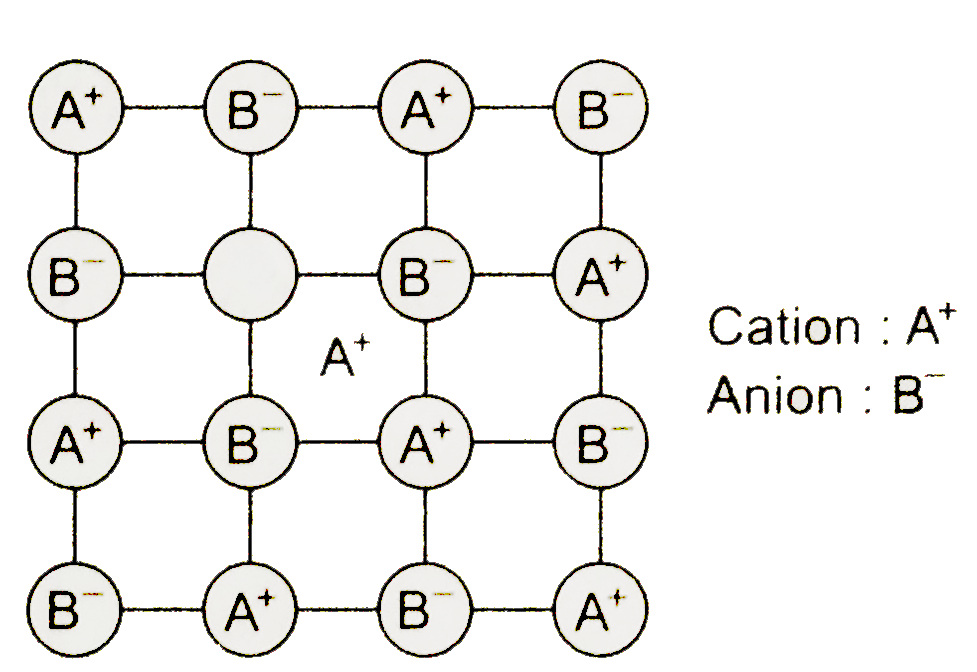In a solid lattice the cation and anion both have left a lattive site. The lattice defect is known as
intestitial defect
vancancy defect
Frenkel defect
schottky defect
The correct Answer is:D
To solve the question regarding the type of lattice defect that occurs when both cation and anion leave their lattice sites, we can analyze the options provided and determine the correct answer step by step.
Step 1: Understand the Types of Lattice Defects
Lattice defects in solids can be classified into several types, including:
- Interstitial defects
- Vacancy defects
- Frenkel defects
- Schottky defects
Step 2: Analyze Each Option
1. Interstitial Defect: This defect occurs when some particles occupy vacant interstitial positions within the lattice. Since the question specifies that both cation and anion have left their lattice sites, this option is not correct.
2. Vacancy Defect: This defect arises when some lattice sites are vacant, meaning that some ions are missing from their positions. However, it does not specify that both cation and anion are missing, so this option is also not correct.
3. Frenkel Defect: This defect occurs when an ion is missing from its normal position and occupies an interstitial site. In this case, only one type of ion is displaced, so this option does not apply to the question.
4. Schottky Defect: This defect arises when both cation and anion are missing from their normal lattice sites. This matches the condition described in the question, where both ions have left their lattice sites.
Step 3: Conclusion
Based on the analysis of the options, the correct answer to the question is Schottky defect. This defect is characterized by the absence of both cations and anions from their respective lattice sites.
Final Answer
The lattice defect is known as Schottky defect.
---
Lattice defects in solids can be classified into several types, including:
- Interstitial defects
- Vacancy defects
- Frenkel defects
- Schottky defects
1. Interstitial Defect: This defect occurs when some particles occupy vacant interstitial positions within the lattice. Since the question specifies that both cation and anion have left their lattice sites, this option is not correct.
Based on the analysis of the options, the correct answer to the question is Schottky defect. This defect is characterized by the absence of both cations and anions from their respective lattice sites.
The lattice defect is known as Schottky defect.
Topper's Solved these Questions
- PRACTICE PAPER -2BOOK - NCERT FINGERTPS ENGLISHCHAPTER - PRACTICE PAPER -2EXERCISE - Practice Paper 2
50 Videos
- PRACTICE PAPER -1BOOK - NCERT FINGERTPS ENGLISHCHAPTER - PRACTICE PAPER -1EXERCISE - Practice Paper 1
50 Videos
- PRACTICE PAPER -3BOOK - NCERT FINGERTPS ENGLISHCHAPTER - PRACTICE PAPER -3EXERCISE - Practice Paper 3
50 Videos
Similar Questions
In a solid lattice the cation has left a lattice sirte and is located at an interstital position , the lattice defect is
View SolutionWhenever, anion and cation approach each other, the valence shell of the anion is pulled towards the uncleus of the anion is pulled towards the nucles of the cation and as a result, the shape of the anion gets cation is known as polarization of polarizing an amion by a cation is known as polarrization. The ability or capacity of a cation of polarizethe anion towards litsef, is known as its polarizing power. Similiarty. the ability or capacity of an anion to get polarized by the cation, is known as its polarizability. As a result of polarisation, the two ions tend to come closer and the ionic character of the ionic ond acquired partial covalent character. The magnitude of polarization depends upon a number of factors whihc were suggested by Fazan and are termed as Fazan rules.
Which is most covalent in nature ?
View Solution
Knowledge Check
When electron are trapped into the crystal in anion cancy ,the defect is known as
AF-centreBFrenkel defectCSchottky defectDInterstitial defect
Whenever, anion and cation approach each other, the valence shell of the anion is pulled towards the uncleus of the anion is pulled towards the nucles of the cation and as a result, the shape of the anion gets cation is known as polarization of polarizing an amion by a cation is known as polarrization. The ability or capacity of a cation of polarizethe anion towards litsef, is known as its polarizing power. Similiarty. the ability or capacity of an anion to get polarized by the cation, is known as its polarizability. As a result of polarisation, the two ions tend to come closer and the ionic character of the ionic ond acquired partial covalent character. The magnitude of polarization depends upon a number of factors whihc were suggested by Fazan and are termed as Fazan rules.
Which has the minimum melting point ?
View SolutionGive two cations and two anions which have the electronic structure of Ne.
View SolutionIonic lattic has two major points defects ,(1) Schottky (2) Frenkel defects . Schottkly defects occurs due to the cations - anion pair's missing from the lattice sites . Frenkel defects occurs when cation leaves its lattice site and fits into an interstitial space. The neutrality of the crystal is being maintained and we considered all losses from interstitial positions.
which defect decrease density of the crystal ?
View SolutionIonic lattic has two major points defects ,(1) Schottky (2) Frenkel defects . Schottkly defects occurs due to the cations - anion pair's missing from the lattice sites . Frenkel defects occurs levels its lattic site and fits into an intersitial space. The neturaity of the crystal is benig maintained and we considerd all losses from interstitical positions.
Structure shown here represents :

View SolutionIonic lattic has two major points defects ,(1) Schottky (2) Frenkel defects . Schottkly defects occurs due to the cations - anion pair's missing from the lattice sites . Frenkel defects occurs levels its lattic site and fits into an intersitial space. The neturaity of the crystal is benig maintained and we considerd all losses from interstitical positions.
Structure shown here represents :

View SolutionAn ionic solid A⊕BΘ crystallizes as an bcc structure. The distance between cation and anion in the lattice is 338±. The edge length of cell is
View SolutionIn a simple cubic lattice of anions, the side length of the unit cell is 2.88Å. The diameter of the void in the body centre is
View Solution